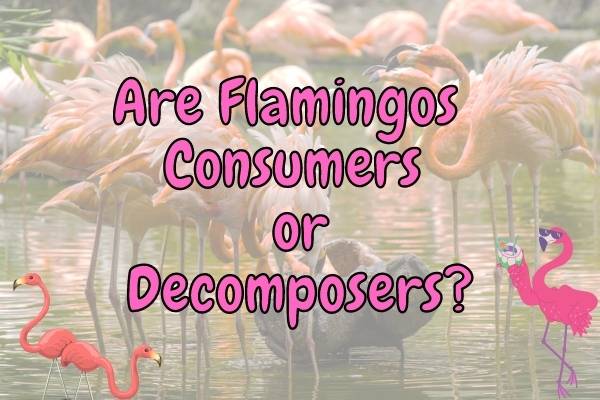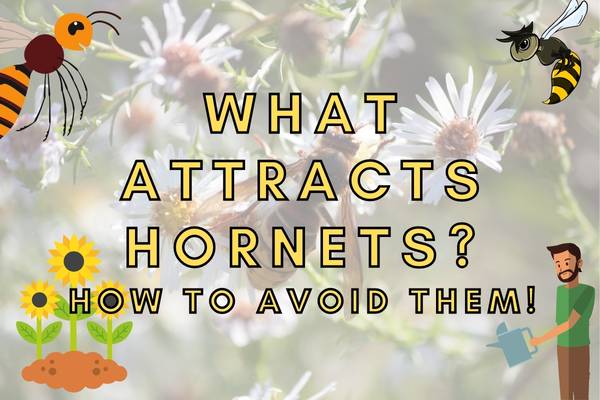Flamingos are filter-feeding sea birds that occur naturally in Africa, Asia, the Americas and Europe. Their diet consists of brine shrimp, blue-green algae, diatoms, and other microscopic organisms.
Flamingos are carnivores, or secondary consumers, because they eat animals and plants and their cross-kingdom diet classifies them as omnivores.
A notable feature of flamingos is their bill structure which is specially adapted for filter feeding but they do not distinguish animals from algae when they filter.
The primary food source for flamingos is Spirulina platensis, a type of blue-green algae that grows in alkaline lakes. This algae is rich in protein and carotenoids which give flamingos their characteristic pink coloration.
Flamingos are important to the coastal ecosystem where they are a keystone species.
They play an important role in maintaining the health of wetland ecosystems by eating large quantities of aquatic plants and animals, which helps to control populations of these organisms.
Flamingos also help to aerate and stir up sediments in wetlands, which helps to keep these habitats healthy.
Contents
Are Flamingos Carnivores, Herbivores or Omnivores?
Flamingos are fascinating and elegant birds known for their vibrant pink feathers and unique feeding behavior. When it comes to their dietary preferences, flamingos are classified as filter-feeding herbivores, with some exceptions depending on the species and environmental factors.
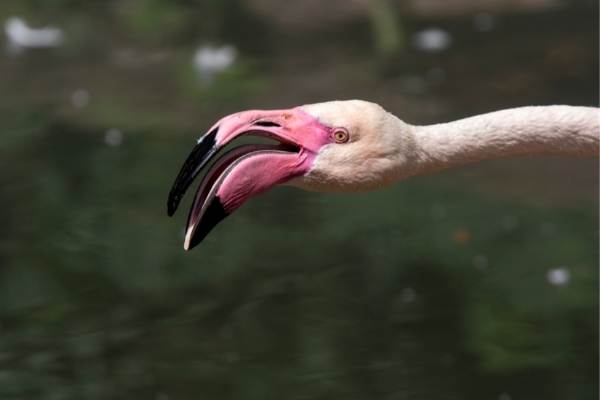
There are six recognized species of flamingos: the Greater Flamingo (Phoenicopterus roseus), Lesser Flamingo (Phoeniconaias minor), Chilean Flamingo (Phoenicopterus chilensis), Andean Flamingo (Phoenicoparrus andinus), James’s Flamingo (Phoenicoparrus jamesi), and American Flamingo (Phoenicopterus ruber).
Although they share certain characteristics, there are variations in their feeding habits.
The majority of flamingo species predominantly consume algae, diatoms, and small invertebrates found in shallow water bodies such as salt pans, lagoons, and coastal areas. These aquatic environments are abundant in microscopic organisms that serve as the primary food source for flamingos. They employ a feeding method called filter-feeding, where they use their uniquely shaped bills to filter out food particles from the water.
The Greater Flamingo, which is the largest and most widely distributed species, often forms large flocks in its natural habitat. They feed by submerging their heads into the water and sweeping their bills upside down.
Their bill contains specialized lamellae, comb-like structures on the inside that help trap tiny organisms. They also have a unique filtering system in their beaks, allowing them to extract food from the water while filtering out excess water and mud.
The Lesser Flamingo, on the other hand, has a distinctive feeding technique. They feed primarily on blue-green algae, which gives them their characteristic pink coloration. These algae-rich environments, such as soda lakes, are a vital part of their diet. Lesser Flamingos have adapted to feed on the upper layer of water, using their lower beaks to scoop up mud and water, filtering out the algae through comb-like structures in their beaks.
While the majority of flamingo species are herbivores, there are a few exceptions to this rule. In certain circumstances, flamingos may exhibit omnivorous behavior, particularly when their primary food sources are scarce. For instance, the Andean Flamingo, a species found in the high-altitude Andean plateaus, has been observed consuming small crustaceans and insects when their usual diet of algae and diatoms is limited.
It’s important to note that the flamingo’s diet can be influenced by various factors, including geographical location, environmental conditions, and food availability. In certain instances, flamingos may opportunistically feed on small invertebrates or aquatic organisms to supplement their diet, but this behavior is not a defining characteristic of their dietary preferences.
In conclusion, flamingos are primarily herbivores that rely on a diet rich in algae, diatoms, and other microscopic organisms found in shallow water bodies.
While some species may occasionally consume small invertebrates or insects, their feeding habits are predominantly herbivorous.
These magnificent birds have evolved unique anatomical adaptations to exploit their aquatic environments and extract the necessary nutrients, contributing to their distinctive appearance and graceful presence in the animal kingdom.
Habitat of the Flamingo
Flamingos are wading birds that inhabit tropical and subtropical areas of the world. Flamingos are most widespread in the brackish waters and grasslands of South America, but are also found in many other places e.g. southern Europe.
Taxonomists disagree about whether flamingos should be placed in their own family (Phoenicopteridae) or in the much larger family Anatidae (ducks, geese, and swans).
Twice in the past, flamingos have been thought to belong with other species of waterfowl. However, recent studies of mitochondrial DNA indicate that flamingos are indeed a unique group. Nonetheless, flamingos continue to be placed with waterfowl in family Anatidae.
Primary Diet of the Flamingo
The primary diet of flamingos consists of plant material, specifically algae, diatoms, and other microscopic organisms. These birds are well-adapted to filter-feeding, which allows them to extract and consume these tiny organisms from water bodies.
Flamingos often inhabit saline or alkaline lakes, lagoons, estuaries, and other shallow water environments.
These habitats are rich in the types of food sources that flamingos depend on. Algae, including blue-green algae, red algae, and green algae, form a significant portion of their diet. These algae provide essential nutrients and pigments that contribute to the vibrant pink coloration of flamingos.
They are best known for their bright pink color, which comes from pigments ingested from their diet of blue-green algae.
Diatoms, which are single-celled algae encased in silica shells, are another important food source for flamingos. These microscopic organisms are abundant in many of the habitats where flamingos reside, and they contribute to the overall nutritional balance of the birds’ diet.
Flamingos employ a unique feeding technique to obtain their food. They submerge their heads in the water, sometimes even upside down, and sweep their specialized bills from side to side. The inside of their bill contains comb-like structures called lamellae, which help filter out the tiny organisms from the water while allowing excess water and mud to be expelled.
By consuming algae, diatoms, and other microscopic organisms, flamingos fulfill their nutritional requirements and maintain their health and vibrant plumage. Their feeding habits also contribute to the ecological balance of their habitats, as they play a role in regulating the populations of these aquatic organisms.
While the primary diet of flamingos is focused on plant material, it’s important to note that some species may occasionally consume small invertebrates or insects, particularly when their usual food sources are scarce. However, such occasions are not the norm and do not constitute the mainstay of their diet.
In summary, the primary diet of flamingos consists of algae, diatoms, and other microscopic organisms. These plant-based food sources provide the essential nutrients that sustain flamingos and contribute to their characteristic pink coloration.
The algae vary in color, with red, orange, and yellow pigments in addition to the blue-green. These pigments, called carotenoids, are thought to give the algae the bright colors and protect them from the sun.
Feeding Habits of Flamingos
Flamingos eat algae, brine shrimp, Spirulina platensis, and other small water organisms that they can filter out.
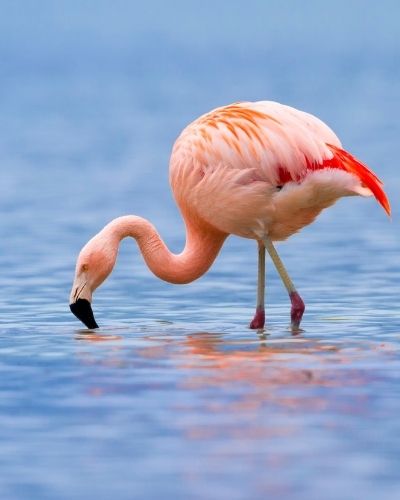
Flamingos ingest their food by filtering it through their beaks and pumping the filtrate down into their stomach.
The beak contains lamellae which act as a sieve to remove food from the water as they feed by swimming with their heads down tilted slightly forward so that the water enters through their mouths and passes out through their nostrils.
What do Baby Flamingos Eat?
Baby flamingos actually drink milk called “crop milk” from their parents the first weeks of life, after which they learn to forage for food themselves.
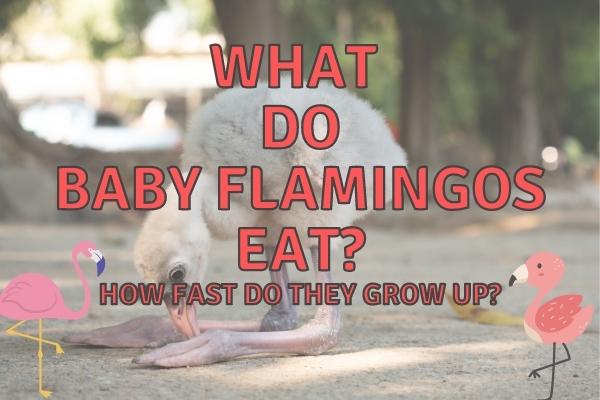
I have written a complete post on the diet of baby flamingos along with 20 fascinating facts about baby flamingos you can read here on the blog!
What Type of Consumer is a Flamingo?
Flamingos can be classified as primary consumers or herbivores. As filter-feeding birds, they primarily consume plant-based material, such as algae, diatoms, and other microscopic organisms found in aquatic environments. These organisms serve as the primary food source for flamingos, and they obtain their energy by feeding on these producers.
Flamingos’ feeding behavior involves extracting and filtering small organisms and organic matter from the water. They use their specialized bills and filtering structures to sieve out their food while expelling excess water and mud. By consuming these plant-based organisms, flamingos play a vital role in the ecosystem as primary consumers, transferring energy from the producers (plants and microscopic organisms) to higher trophic levels.
It’s worth noting that while flamingos are primarily herbivores, some species may exhibit opportunistic omnivorous behavior in certain circumstances. However, this behavior is not a defining characteristic of their feeding habits, and their primary role as consumers is linked to the consumption of plant material.
Can Flamingos be Considered Decomposers?
No. Flamingos eat only living animals and plants and do not eat dead or decaying matter. Therefore, they do not qualify as decomposers.
Where are Flamingos in the Food Chain?
The food chain is complicated, but flamingos are somewhat in the middle of the food chain. Other animals eat flamingos, but flamingos eat other animals as well. In Africa, apex predators such as lions, cheetahs, leopards and jackals will hunt and eat flamingos.
But flamingos are omnivores and secondary consumers because they also eat animals.
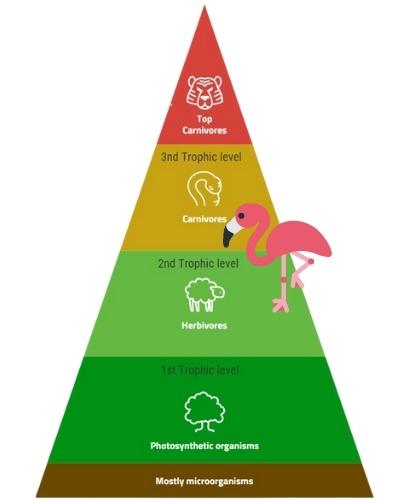
Animals that only eat plants are primary consumers and are placed on the second trophic level in the energy pyramid, but flamingos are placed just above these at the third trophic level because they also eat other animals.
Flamingos are important for the ecosystem because they help to maintain the balance of prey and predators in their environment.
As a result, flamingos help to keep the populations of other animals in check and prevent any one species from becoming too dominant.
Additionally, flamingos play an important role in dispersing eggs and seeds and helping to spread plant life throughout their habitat.
Are Flamingo Autotrophs or Heterotrophs?
Flamingos are heterotrophs because they eat other living organisms. Practically no animals are autotrophic because animals do not get their energy directly from the sun like plants do. That is, animals like the flamingo do not make their own energy, but need to eat other organisms as their energy and carbon source.
Conclusion
In this blog post I have looked at the diet of the flamingo as a bird that is often misunderstood because of the way it looks!
Flamingos are a group of birds that are very interesting consumers because they are able to filter out both plants and small animals from water using their unique beak!
Flamingos are very interesting birds because they are able to eat the small crustaceans found in the water, as well as the plants that grow in the water.
Flamingos are found in many different places, but they are most common in the warmer regions of the world. However, flamingos are not as common as they once were, and their numbers are declining.
If you are interested in the food chain and how it works, I have written several posts on animals and their role in the food chain here on the site!

